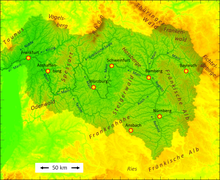Main (river)
![]()
The title of this article is ambiguous. For other meanings, see Main (disambiguation).
With 527 kilometres of flow, the Main is the longest right tributary of the Rhine.
The source rivers of the Main originate in the Fichtelgebirge (White Main) and in the Franconian Alb (Red Main). At the western edge of the city of Kulmbach in the district of Melkendorf near Steinenhausen Castle, the two headwaters join to form the actual Main. Despite many striking changes of direction, the course of the river maintains its main flow direction from east to west, which is rare in Central Europe, and touches several Franconian low mountain ranges. Large parts of the Franconian wine-growing region and numerous, partly well-preserved historic town centres lie along the Main. The Main flows through large conurbations around Würzburg and Frankfurt. Opposite the old town of Mainz - between Ginsheim-Gustavsburg and the Maaraue in Mainz-Kostheim - it flows into the Rhine. From there (kilometre 0) upstream to above the railway bridge at Hallstadt (kilometre 387.69), the Main (Ma) is a federal waterway.
The Main is not exceptionally long, but nevertheless a historically and geographically important river. In late antiquity, its lower course from Miltenberg was the outer border of the province of Upper Germania of the Roman Empire. In the 19th century, the Main line separated the spheres of influence of the two major German powers, Austria and Prussia, within the German Confederation with its headquarters in Frankfurt directly on the Main. The Main, which actually runs within Upper Germany, is neither a dialectal nor a cultural border, but according to common understanding the Main line divides Germany into a northern and southern part. In terms of transport geography, the Rhine-Main area is the centre of Germany and Europe.
Data
Different lengths are given for the Main. The reason is that different origins and thus headwaters are attributed to the river in each case. Together with the longer headwaters, the Roter Main, a flow length of 527 km results, together with the larger but shorter headwaters Weißer Main one of 518 km. From the confluence of these two headwaters, the Main has a length of 472 km. About 81 km downstream of the confluence the Regnitz enters, which is much larger than the Main there. If one considers the waterway from the course of the Regnitz together with its main headwaters Rednitz and again its own main headwaters Fränkische Rezat as a source river, the total length is even 553 km. Before German reunification, the Main was sometimes called the longest river flowing exclusively in the then Federal Republic.
The catchment area of the Main and its tributaries covers 27,292 km² and extends over most of Franconia, the north-easternmost part of Baden and the north of southern Hesse. It borders the Danube catchment area in the south (a few hundred metres south of the source of the Weißmain lies the source of the Fichtelnaab, which drains into the Black Sea via the Naab and Danube); the boundary between the two is part of the main European watershed.
With an average discharge of 211 m³ per second at its mouth into the Rhine, the Main is the fourth largest tributary of the Rhine after the Aare (560 m³/s), Meuse (357 m³/s) and Moselle (315 m³/s).
The 388 km long navigable stretch begins near Bamberg and has been connected to the Danube via the Main-Danube Canal since 1992. There are several large inland ports, especially in the Rhine-Main conurbation around Frankfurt.
The Main runs through the federal states of Bavaria and Hesse. Baden-Württemberg has a share of the left bank in the area of the towns of Freudenberg and Wertheim over a length of around 25 km.
The Main hiking trail and the Main cycle path run along the Main.
See also: List of cities and towns on the Main River

Catchment area of the Main
Name
The name Main is of Celtic origin; the Celts called the river Moin or Mogin. When the Romans came to the area at the beginning of the 1st century AD, they Latinized the name to Moenus. The oldest record (as Moenis) is given by Pomponius Mela (shortly after 43/44 AD), later mentions are found e.g. in Pliny (Naturalis historia) or Tacitus (Germania). Rivers with similar names exist in Ireland (Maoin) and Britain (Meon, lat. maionus). Several explanations are considered for the origin of the name. Some authors trace it back to an Indo-European word mei meaning water (cf. Latvian maina or Lithuanian maiva: marsh), others to a wall or fence (cf. Latin moenia: ring wall). In the Middle Ages the river was mostly handed down as Moyn or Moyne, the name Meyn first appeared in the 14th century.
In the dialects spoken on the Main (from the 17th to the 19th century also called Main river) the river has the following names:
- Maa in Upper Franconia,
- Mee in eastern Lower Franconia,
- Moa Wertheim area, Miltenberg area, Aschaffenburg area (district)
- Mää City of Aschaffenburg, Main-Spessart
- Maa (locally partly nasalized, partly evaporated), Seligenstadt area, Frankfurt area
Search within the encyclopedia